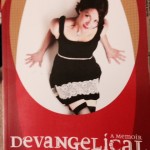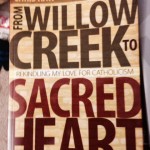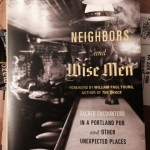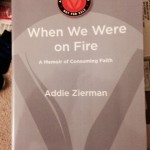The post-evangelical memoir has exploded as a genre in the wake of Rachel Held Evans’ 2010 Evolving in Monkey Town: How A Girl Who Knew All The Answers Learned to Ask The Questions. Since that time, an industry of thirty-something post-evangelical memoirists has blossomed. And it seems like 2013 was the year that they all got published (or at least read by me). I read four post-evangelical memoirs this year that were each very different: Erika Rae’s Devangelical, Chris Haw’s From Willow Creek to Sacred Heart, Tony Kriz’s Neighbors and Wise Men, and Addie Zierman’s When We Were On Fire.
1) Erika Rae’s Devangelical
Erika Rae’s memoir is probably the cheekiest. At least I found myself laughing out loud frequently as I read it.
She starts off talking about the matter-of-fact expectation of the end of the world in evangelical circles: “While the average person may occasionally enjoy getting goose bumps about the extinction of humankind, evangelicals thrive on it. As in, they expect it. Pray for it. Indeed, the average Evangelical craves it. Why? Because it means that this temporary life will end and a real one will begin” (19).
She relates attending a slumber party at a non-church friend’s house where all the stereotypical things happened that fundamentalist parents are paranoid about: “Had the dancing opened the possibility for Light as a Feather, which in turn, had led to the Ouija board? Or had it been the presence of the Ouija board that had influenced the dancing? Or was the Ouija board and Light as a Feather in a class of their own and the dancing… was just fun? (40).
Her youth group went on a field trip to a new age convention to fight spiritual warfare: “It was worse than I thought. The entire floor of the arena was filled with sin. For as far as the eye could see, there was booth after booth selling the Devil’s wares: meditation books, crystals, dragon sculptures, smoking devices–it was endless” (54).
And finally when the sexual temptation that evangelical youth culture is obsessed with and built around got too intense, there was only one thing for her and her boyfriend Scott to do: “We knew two things at the ripe age of 19. One: we wanted to have sex. Two: premarital sex was wrong. Thinking about it was wrong. Planning for it was wrong. And doing it was definitely wrong. We were supposed to be hot for God, not each other. There was only one way around it: Marriage” (130-131).
Erika and Scott managed to stay together. They are still Christian, though not evangelical. They still attend church regularly, though the church is too “liberal” for her parents’ tastes. After the bemused, mischievous tone of most of the book, the end really cut into my heart as Erika describes the death of her father and the unresolved conflict between them. It was an unusual ending for a mostly lighthearted memoir, but it reflected a real truth. Post-evangelicals joke around about our upbringing to a point, but we still deeply love the people who made us who we are even if we disagree with them.
2) Chris Haw’s From Willow Creek to Sacred Heart
Chris Haw takes a unique approach to describing his conversion from nominal Catholicism to evangelicalism back to Catholicism. He spends the first half of his book sharing his personal story discovering and getting involved with the Willow Creek megachurch, going away to college at Eastern University where he discovered a social justice-oriented evangelicalism, and then starting an intentional community in Camden, New Jersey where he found his way back to Catholicism in the neighborhood parish. The second half of the book provides a theological reflection on Haw’s newly discovered Catholicism framed according to evangelical sensibilities.
Throughout the book, Haw maintains a thoughtful, charitable tone, refusing to denigrate his evangelical past or whitewash his Catholic present. He does share that his immersion in a non-denominational environment did give him a bit of a condescending attitude toward Christians devoted to specific denominations: “Why couldn’t they give up their silly rituals, dogmas, and traditions for the sake of simply following Jesus–without reference to the past?” (15).
Haw shares how he got involved in social justice activism at Eastern University after befriending both Shane Claiborne and Jonathan and Leah Wilson-Hartgrove who both attended there also. He went on an immersion study program in the jungle of Belize. He went with Jonathan and Leah to Iraq with the Christian Peacemaker Team in 2003 at the start of the war. Then a guest presentation on environmental racism at Eastern by Father Michael Doyle laid the groundwork for Haw to start an intentional community with some friends in a tough neighborhood in Camden, New Jersey.
The part that I most enjoyed in the book was the second part where Haw examines the theological implications of his conversion. Catholic converts can sometimes be insufferable in their zeal, but Haw’s humility and openness about his lingering disagreements with the Church makes him a very compelling apologist.
Haw makes a powerful case for the Catholic crucifix over the Protestant empty cross: “Even if Jesus is resurrected, the wounds and scars still remain, just as our violence still remains to this day. The one who truly sees Christ crucified is, however joyful in his experience of forgiveness, always tempered and humbled as one who has witnessed the torturing and execution of another human, killed from our own betrayal or indifference. Far too often, instead our theologies of atonement and pious patriotism can dress up or obscure the painful lament at the sight of the Cross. It didn’t seem coincidental, then, that many people from the evangelical community in which I heard this disdain for the crucifix’s imagery, who had removed the Cross but kept the flag, were also often overlooking or rationalizing the deaths of civilians in our current wars” (92).
He goes through an excellent engagement with Rene Girard to talk about the experience of the cross’s atonement in Catholic liturgy. For someone who’s been wanting to tap into Girard, Haw presents a very accessible and creative reading that is worth the price of the book in itself. It was hard to find a short, representative quote, but here’s a creative application that he concludes with: “There is a desperate necessity for exalting martyrs in the wake of the Gospel’s myth-dissolving force: without being accompanied by a community of compassionate suffering and virtue, the Gospel will only cut and not mend. Simply, the Word of Christ needs to be accompanied by the Body of Christ–that community of positive mimesis, of a culture bound together by a different kind of ‘sacrifice,’ the ‘anti-sacrifice’ of Christ. And so one of the Christian’s tasks is not only to proclaim ‘Christ crucified,’ that we blindly murdered the Lamb of God, but also that we must remain like lambs in a world of wolves” (117).
In addition, Haw provides a helpful defense of the Catholic use of saints: “If Christ interpreted God, we have to keep identifying the best interpretations of his interpretation. Naming saints, people who have interpreted the life of Christ by living in their own unique way, is like being able to sight down the barrel of a long rifle–the longer the rifle is, the more accurate it is; the shorter the barrel, the more dangerous and haphazard” (136).
He also deals with the church pedophilia scandal and the question of church corruption in general very thoughtfully and openly: “I have gotten some mileage out of that provocative claim, ‘The Church is a whore, but she is our mother.’ While she–in both her leaders and her common members–often dirties the bathwater, she is also the one who championed water sanitation and told us how to wash up… We’ve all heard the old and easily misused proverb to hate the sin, love the sinner. In applying this to the Church, I’m not only suggesting to love it but to hate its sins. I’m coming to see a more profound reality: that the Church’s tradition is the very thing that told us what sins are. This has helped me forgive the Church for her evils–for the Church taught me forgiveness and how to identify evil” (157).
Just be careful. Reading this book might make you turn into a Catholic. I was half-ready to do that when I put it down.
3) Tony Kriz’s Neighbors and Wise Men
Tony Kriz may be the most “post” of the four post-evangelicals I read. He’s gotten kicked around a lot. He shares his wounds bravely and with a lot of grace for those who created them by yanking him first from the mission field in eastern Europe and then from campus ministry at Reed College. The book culminates in a beautiful vision for what parish ministry could look like when your parish really is the people in your neighborhood and not just the people who come to your church. If you think of yourself as a “missional” type of Christian, you should definitely check out this book.
During his time as a missionary in Albania, Tony lived with a Muslim family that stayed Muslim the whole time he was there and for which he gained a lot of respect over time. He shares his ambivalence after witnessing the conversion of one Muslim to Christianity: “My team had won again. We had added another name to our role and taken a name from theirs. But in time, I had to repent of seeing my friend as some sort of Christian conquest. I was blinded by my belief that my team was ‘better,’ so much that I could not see the cost. In time I realized what it took for a young, proud man to do what I had never, ever considered doing… following the path of faith wherever it might lead… even if it meant immersing himself in an opposing religion… Eventually, Luli became my teacher” (46).
When Tony ends up in a confrontation with two Muslim evangelists who came to the town where he was living, they have a very polite and amicable conversation in which the Muslim guys seem to “win” the debate. Tony writes, “Later, I thought more about those Muslim scholars in their woolen hats, beards, and long robes. I realized that they looked like the Magi (wise men) in my childhood Nativity set. Who were the Magi anyway? They were spiritual scholars from the East who honored Jesus… Did the Magi hold to all the theological intricacies that we Christians believe today? I somehow doubt that they did” (56).
Some of Tony’s most interesting adventures come about in a Portland bar called the Horse Brass. He relates several conversations with bar regulars during a time when he was feeling spiritually ungrounded. They end up being his spiritual guides in a time when he was wanting to give up his faith. Like Pope, a spiritual not religious guy studying the Kabbalah. Or Katarina, a sixty-something year old liberal Jew who despite her age is pursuing a doctorate in religious studies. Eventually, Tony winds up being a campus minister at Reed College where he acquires a new set of conversation partners, many of whom are “de-Christians” who were disillusioned from the faith at some point in the past. Throughout his book, Tony honors the people with whom he walks in ministry as his teachers.
I really appreciated a metaphor that Tony uses to talk about his approach to evangelism: “What if ‘sharing the gospel’ was not so much like sharing a chocolate cake, where one person has privileged access and the other has not? What if sharing the gospel was instead like sharing a sunset? Sharing a sunset is quite different from sharing cake… As you share a sunset, you must stand shoulder to shoulder, not face-to-face. When you share a sunset, both observers are caught up in the glory and beauty and mystery. When you share a sunset, everyone present has equal opportunity to contribute” (172).
I have really found myself resonating with Tony’s philosophy of evangelism. I think it’s about admiring God’s beauty in the company of another person. While I don’t think “all paths lead to heaven” or that every perspective is just as good as any other, I don’t see a lot of value in making sure that it’s clear that I’m the one in the know and the person I’m talking to is not. I have learned the most from teachers who were interested in learning from me. Tony seems like a real teacher.
4) Addie Zierman’s When We Were on Fire
Addie opens her memoir with a poignant scene: standing at the school flagpole in the rain, thinking she was the only kid who had come out to pray at the annual See You at the Pole prayer event. “I wanted the empty courtyard,” she writes, “the chance to be a solitary figure at the pole. To be the only one bold enough, brave enough, passionate enough to stand in the rain for Jesus” (6). It turned out that all the other evangelicals had made a prayer circle inside the front hallway. Addie’s friend comes out to get her, and she realizes that she wasn’t the solitary prayer warrior hero, just a lonely, wet kid standing in the wrong place.
There’s something about that image that really captures something about my experience with evangelical culture. I don’t know how many other people felt like there was a secret password that they didn’t know or instincts and lingo that everyone else seemed to grasp intuitively except you. The other trope of evangelicalism that Addie captures is its genderedness. Boys are supposed to be missionaries; and girls are supposed to be missionary wives.
She spends a lot of her book talking about her first love, a guy named Chris she dated and broke up with throughout high school: “He led Bible studies and he led prayer groups and he led people int he Prayer of Salvation. The binding on his Bible was falling off from so much opening and closing, the words marked by his underlines, the margins heavy with his notes. When he talked about faith, he used words like revival, words like spiritual battle and prayer warrior and sacrifice. He signed his e-mails and letters with the phrase Consumed by the call” (35).
I smacked my head a lot remembering how I was as a teenager when I read about Chris’s uber-zealous piety in their relationship: “A few weeks after we started dating… he drew up a contract for our relationship and went through it for me point by point at a Barnes and Noble coffee shop… There were eleven or twelve points, most of which I cannot remember. The first involved putting God ahead of our relationship at all times. The second restricted our physical affection to handholding and hugs… Below he had created several lines for signatures: mine, his, each of our parents’, the youth pastor’s, and even the head pastor’s… When I brought the contract home to my parents, my dad laughed, as if it were a joke” (82).
Addie and her friends tried to emulate Chris’s uber-piety by breaking into the school cafeteria late at night to anoint the cafeteria tables with vegetable oil and pray for “revival” to come to their school: “The container held a couple of tablespoons of Aldi-brand vegetable oil, which we had because we were planning to ‘anoint’ the cafeteria table. We’d heard there was specific oil made for this task, but we didn’t have any. Anyway, plain oil cooking oil was what I had seen Christ use the week before. I’d never heard of this symbolic gesture before I saw him ‘anoint’ the door frame of the home of one of his friends before a prayer meeting” (40).
I wonder if there’s something about the message evangelicals receive in youth group that makes us think that we’re all supposed to be “leaders.” I feel like I’ve always been haunted by the need to be the biggest fish in whatever pond I find myself in. I’m not sure where that comes from, but I really related to Addie’s observations on arriving at her evangelical college: “I felt very aware that there were twenty-five hundred students at Northwestern, most of them Bible study leaders and prayer group leaders from high school youth groups around the country… I remember realizing that I would have to vie for what used to be my most defining characteristic: my faith. The spectrum would be defined differently now; there would be a new ‘top’ and a new ‘bottom.’ After all, we couldn’t all lead Bible studies here” (103).
In college, evangelicals get even more extreme than they were in high school. Addie relates the hyper-zeal of the RA for her freshman dorm: “‘One thing I do is I have this plasty baggy,’ she continued oblivious to my distractedness. ‘And I write Bible verses on note cards and I put them inside of it, and then I hang it in the shower.’ She smiled big, pleased with her creativity. ‘That way, I can dwell on God’s Word while I’m getting ready in the morning.’ She looked at me with wide, expectant eyes, so I said something like, ‘That’s a great idea’… ‘I have one for you if you want.’ ‘Sure,’ I said, gritting my teeth into a smile” (110).
Addie starts to break away from the zeal competition in college after meeting a boy named Andrew whom she ends up marrying: “If he cared what people thought of him or his faith, he never showed it. He did not vie for positions of spiritual leadership or talk about his life’s calling… He had a casual disregard for Northwestern’s many Rules. It’s not as if he set out to break them, he just didn’t factor them into his daily decisions… He laughed, and he made me laugh, and it was because his relationship to his faith was not a do-or-die mission but something life-giving and fluid” (114-115).
The adventures continue from there. Addie’s relationship with Andrew survives an English teaching experience in China with a community of fundamentalists from Michigan, an oppressive house church, a phase of Addie’s binge-drinking, and a narrow escape from infidelity with a hipster guy at Caribou Coffee. This book left me feeling the most hopeful, probably because Andrew and Addie were able to stick together after some heavy things happened that would have torn many relationships apart.















